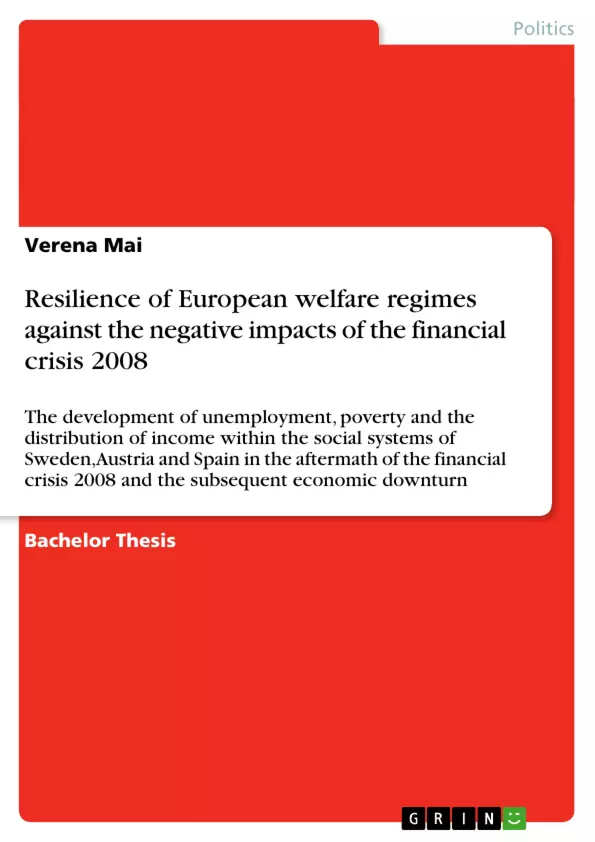The financial crisis, which struck the EU countries in 2008, was followed by the severest economic recession since the end of the Second World War, involving a significant drop in GDP (negative economic growth) for most of them. Output growth has turned negative or stagnated in several countries, the impact on labour markets has led to rising unemployment rates and public debt and deficits have soared. In the aftermath of the crisis countries were confronted with a deteriorating social context, which is due to the severity of the economic downturn, the worsening job situation and the increased unemployment. This has resulted in a heightened need for social protection while at the same time making it more difficult to finance.
The crisis has highlighted the role of social protection as a social buffer and an economic stabilizer that cushions the impact of recessions. Social benefits have been an essential element of national crisis response in the countries of the European Union. Social security programmes not only act as an important component of the crisis „exit strategy“, helping to revitalize the economy but they also protect the most vulnerable part of society. One of the lessons that can be learned from the crisis is that countries and their inhabitants are differently exposed to economic shocks due to the variations in the design of social security that they are covered with. This consideration is essential to analysis because, as Őzdemir et al (2010) point out, the origins of the crisis can be spotted in the financial sector, where income levels tend to be relatively high. Nevertheless, there is piecemeal evidence that the most vulnerable in society have to struggle most with the negative consequences of the crisis.
This work examines the capacity of specific types of welfare states, classified mainly according to Esping-Andersen’s concept, to absorb macro-economic shocks – in particular with reference to the most vulnerable parts of society. Which social policy challenges arise in Sweden, Austria and Spain and which differences in the economic and socio-political impacts of the crisis can be identified? The question regarding the ability of a system to handle external disturbances gains importance, as one of the main claims after the outbreak of the financial crisis is to improve our political, economical and societal systems to become more resistant or resilient.
Inhaltsverzeichnis (Table of Contents)
- 1 Introduction
- 2 Challenges for Three European Welfare States: Sweden, Austria and Spain
- 2.1 Welfare State Typology
- 2.2 A typology of economic crises
- 2.3 Impacts of the financial crisis on national budgets (2007 - 2010)
- 3 Impact of the Crisis on Unemployment, Poverty and Distribution
- 3.1 Unemployment: Developments in Sweden, Austria and Spain in comparison
- 3.1.1 Unemployment rate of the total population (from 15 to 74 years)
- 3.1.2 Youth unemployment rate and youth unemployment ratio
- 3.1.3 Unemployment rate according to the highest level of education
- 3.2 Poverty: Developments in Sweden, Austria and Spain in comparison
- 3.2.1 Poverty rate of the total population
- 3.2.2 Youth-poverty rate
- 3.2.3 Old-age poverty rate
- 3.2.4 Poverty rate of single parents with one dependent child
- 3.2.5 Summary of the findings concerning poverty
- 3.3 Distribution: Developments in Sweden, Austria and Spain in comparison
- 3.3.1 Which lessons can be learned from past recessions concerning distributional effects?
- 3.3.2 Which lessons can be learned from the current crisis concerning distributional effects?
- 3.3.3 Summary of the findings concerning the Gini coefficient
- The impact of the 2008 financial crisis on European welfare states
- The development of unemployment, poverty, and income distribution in Sweden, Austria, and Spain following the crisis
- The role of different welfare state models in mitigating the negative consequences of the crisis
- The vulnerability of different social groups to economic shocks
- The importance of social protection as a social buffer and economic stabilizer
- Chapter 1: The introduction discusses the impact of the 2008 financial crisis on the European Union, including the resulting economic recession, rising unemployment, and increased public debt. It also highlights the importance of social protection during economic downturns and the need for analyzing the effectiveness of different welfare state models in mitigating the negative consequences of the crisis.
- Chapter 2: This chapter provides an overview of the welfare state models in Sweden, Austria, and Spain. It examines their respective characteristics, including their historical development and key policy features. The chapter also analyzes the impact of the crisis on national budgets in these countries, focusing on government revenue and expenditure, as well as public debt.
- Chapter 3: This chapter analyzes the development of unemployment, poverty, and income distribution in the three countries after the financial crisis. It examines trends in unemployment rates, focusing on different subgroups like youth and those with different education levels. It also explores trends in poverty rates, considering overall poverty, youth poverty, old-age poverty, and single-parent poverty. Finally, the chapter examines the distribution of income using the Gini coefficient and discusses lessons learned from past and present recessions regarding distributional effects.
Zielsetzung und Themenschwerpunkte (Objectives and Key Themes)
This paper examines the impact of the 2008 financial crisis on unemployment, poverty, and income distribution in Sweden, Austria, and Spain. The research seeks to understand how these welfare states responded to the crisis and whether variations in their responses can be attributed to their different welfare state models.Zusammenfassung der Kapitel (Chapter Summaries)
Schlüsselwörter (Keywords)
This research focuses on the impact of the 2008 financial crisis on European welfare states, particularly Sweden, Austria, and Spain. Key themes include unemployment, poverty, income distribution, welfare state models, social protection, and the economic consequences of economic shocks. The research also examines the vulnerability of different social groups and the importance of social security in mitigating the negative impacts of economic crises.- Quote paper
- Verena Mai (Author), 2012, Resilience of European welfare regimes against the negative impacts of the financial crisis 2008, Munich, GRIN Verlag, https://www.grin.com/document/214912



